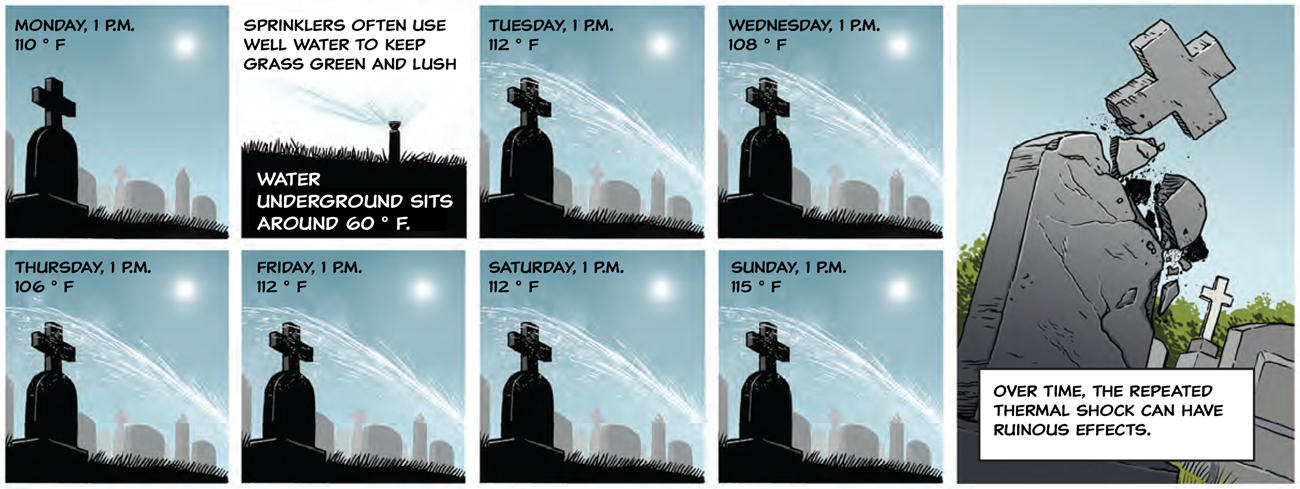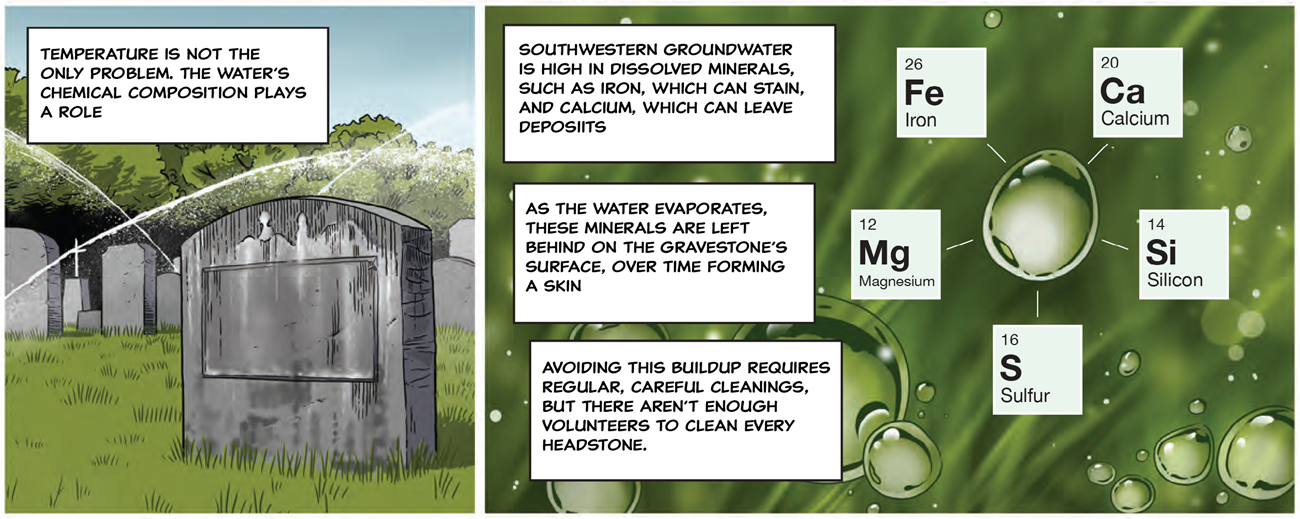Last updated: April 7, 2025
Article
Gravestones Bite the Dust
NCPTT Cemetery Conservation
By Johnna Rizzo and Matthew Twombly








Transcript and Image Description
Line 1: In the 1800s, Texas saw Mormon pioneers settling the West, Chinese immigrants building the railroad, and notorious outlaws like John Wesley Hardin.
Image Description: A three-scene panel shows: A wagon train of a dozen crosses the plains. Four Chinese railroad workers align a set of steel rails across wooden ties while another worker carries water. A pair of gungfighters are on the deserted street of a western town, one fires, as the other clutches his stomach and drops his pistol.
Line 2: These figures rest in Concordia Cemetery in El Paso, Texas. Their history remains written on well-preserved headstones in this dry, dusty place.
Image Description: Dozens of different stone grave markers, many with crosses, crowd a sparsely vegetated landscape, with low mountains in the background.
Line 3: Meanwhile...in other parts of the Southwest, landscaping intended to make cemeteries
look attractive may actually be destroying gravestones.
Image Description: A tightly packed cemetery with grave markers has a lush green grass lawn with trees in the background.
Line 4: Sprinklers often use well water to keep grass green and lush. Water underground sits around 60ºF. Over time, the repeated thermal shock can have ruinous effects.
Image Description: A series of images clockwise show the silhouette of a granite grave marker receiving spray from a water sprinkler, Monday through Sunday, daily at 1:00PM, showing temperatures of 110ºF, 112ºF, 108ºF, 106ºF, 112ºF, 112ºF, and 115ºF respectively. The headstone shatters.
Line 5: Stone, like most material, expands as it gets hot. And contracts as it gets cold. As hot stone is shocked with cold water exposed areas contract quickly, resulting in cracks.
Image Description: Three square stone samples: The first expands as it grows warm, the second shrinks as it cools, a third hot stone shatters when shocked with cold water.
Line 6: Granite, a common material for gravestones, is especially good at holding heat.
These stones can reach temperatures more than 40 degrees higher than the surrounding air on a sunny day, and the darker the stone, the hotter it gets.
Grounds are watered once a day, generally in the mid-afternoon, when the Sun and temperatures are at their peak.
Image Description: A cracked granite gravestone amid debris sits on a well-manicured cemetery lawn while showered with a water sprinkler.
Line 7: Temperature is not the only problem. The water’s chemical composition plays a role.
Southwestern groundwater is high in dissolved minerals, such as iron, which can stain, and calcium, which can leave deposits.
As the water evaporates, these minerals are left behind on the gravestone’s surface, over time forming a skin.
Avoiding this buildup requires regular, careful cleanings, but there aren’t enough volunteers to clean every headstone.
Image Description: Two panels: First, a stone grave marker is misted with water. The next shows droplets of water, and breaks out contaminants by periodic table elements: Iron (Fe, 26), Calcium (Ca, 20), Silicon (Si, 14), Sulfur (S, 16), and Magnesium (Mg, 12).
Line 8: Watering in the early morning while graves are still cool can minimize mineral deposition and prevent thermal shock. even better, keeping the native landscaping is a sure way to preserve the pieces of america’s history among the headstones for generations to come.
Image Description: A trio of mourners walk through a dry Southwestern graveyard, flags marking veteran graves. A man in a sportcoat walks ahead. Two women in black dresses carry white flowers. A couple visits a grave in the background.
Source: National Center for Preservation Technology and Training, National Park Service.
